The Chromebook Pixel (2015) Review
by Brandon Chester on March 16, 2015 8:00 AM EST- Posted in
- Laptops
- Chrome OS
- Chromebook
- Chromebook Pixel
Display
When the original Chromebook Pixel launched two years ago, its big selling point and the source of its name was its 239ppi 2560x1700 display. At that time, the only other laptops on the market with HiDPI displays were Apple's Retina MacBook Pros. Chromebooks have typically aimed for the low-cost segment of the laptop market, and so it was quite a surprise that one of the earliest HiDPI laptops was a Chromebook. Although the Pixel had the highest pixel density of any laptop display at the time, it fell somewhat short when it came to color reproduction due to its narrow color gamut and lack of calibration. With the new Chromebook Pixel, Google has advertised coverage of the sRGB color gamut, along with a maximum brightness of 400nits.
To see whether or not Google has hit their mark, we turn to our standard display testing workflow. As usual, all measurements are performed using SpectraCal's CalMAN 5 software along with X-Rite's i1Pro 2 spectrophotometer, with the exception of black level measurements which are performed with an i1Display Pro colorimeter.
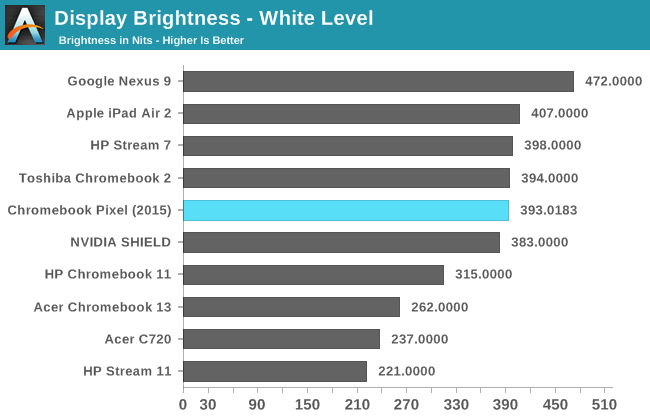
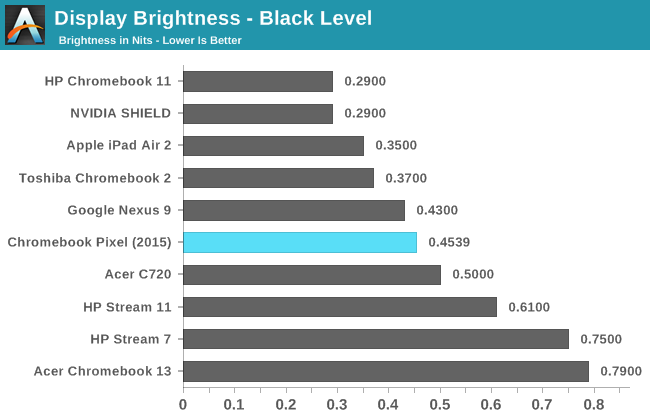
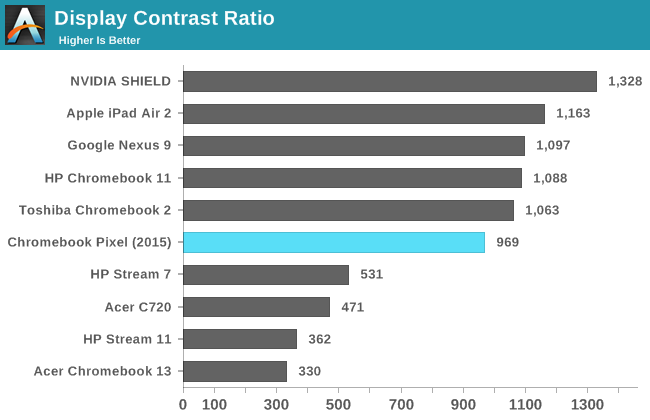
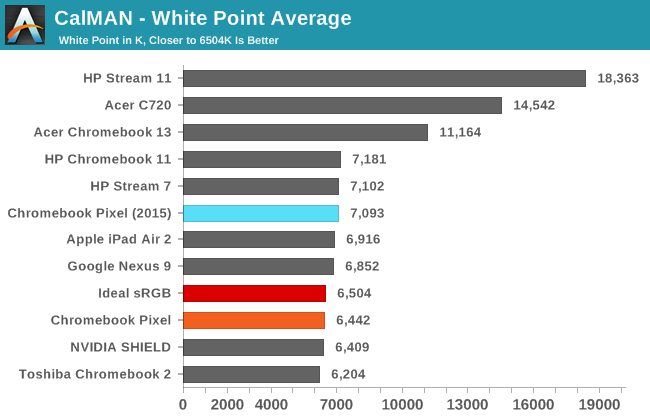
Due to the evolution of our display workflow as time has gone on, I don't have results to compare the new Pixel to the original for certain categories. The result for maximum brightness is certainly in line with Google's advertised 400nit brightness, while the black levels and contrast ratio are what you would expect of IPS panels. The white point is noticeably more blue than the ideal D6504 target, which contrasts with the original Pixel which was very slightly too red. The blue/green tint in white and shades of grey is also more obvious than most other devices with similar average white points, which I elaborate on further below.

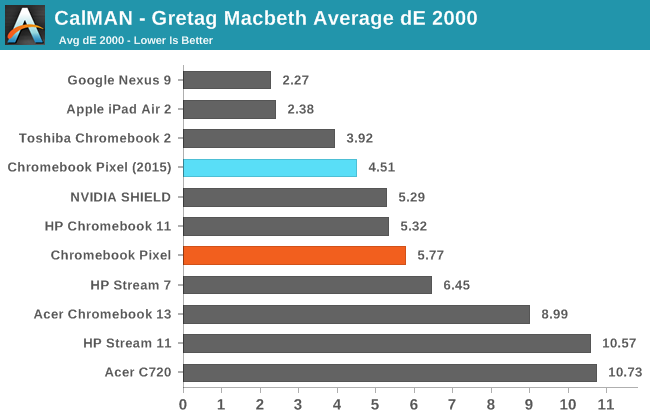
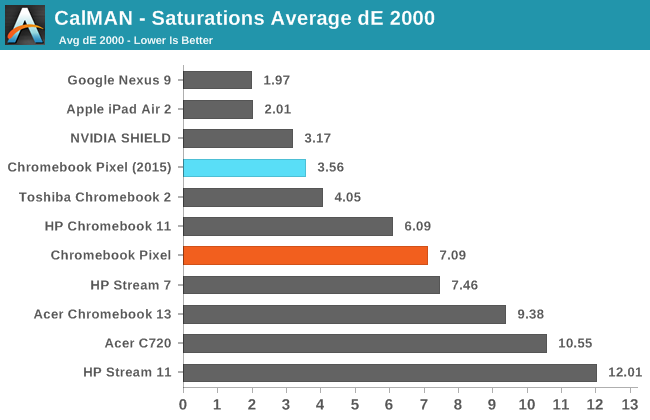
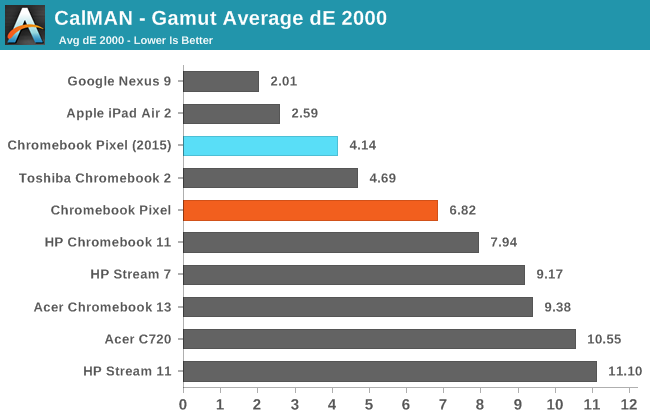
The new Pixel improves significantly upon the original in the gamut and saturation tests. It has a much wider gamut than the original, although it misses in magenta and yellow. Saturation improvements follow the improved gamut, as colors of 80% and 100% saturation no longer look identical. Despite these improvements, there hasn't been much progress on greyscale and color mixture accuracy. As noted earlier, the Pixel has a fairly obvious green/blue tint to the lighter shades of grey and white. As you can see in the gallery below, this is due to the reduction in red and increase in blue components of luminance as the shades of grey move from black to white.
I don't expect that many Chromebook users will be doing heavy photo and video editing that requires a perfectly calibrated display. Many $999 laptops ship with displays that are much worse than the one on the new Pixel, and I think that most users will be very happy with the Pixel's display. It's just a shame that Google doesn't seem to have put the same amount of care into display calibration with the Pixel as they have with the Nexus 9 and other Google branded devices, despite it having the highest price point of the devices they sell.
















123 Comments
View All Comments
steven75 - Wednesday, March 18, 2015 - link
The problem is this is a barely-higher-than Corolla quality device at a non-Corolla price.whatsa - Monday, March 16, 2015 - link
A chrome os dev would be smarter to buy the cheap one to do performamnce testing.sorten - Tuesday, March 17, 2015 - link
Exactly. This would be the worst choice for dev or testing. For dev you want a real OS and a CPU with a larger TDP envelope for quick builds and for testing you want a piece of crap for testing the worst case scenario.jabber - Wednesday, March 18, 2015 - link
If you are a serious ChromeOS developer and can buy the Pixel then you can afford $250 for a standard Chromebook for testing too. To be honest development is a business of sorts. If you can't afford a couple of thousand dollars for hardware/software costs then maybe look to do something else. Annoys me when people setup in business or run a business and then baulk at spending say $200 on software that will enable them to potentially make $200000.NeatOman - Monday, March 16, 2015 - link
The only thing that seperates this from another $1000+ laptop is storage which google doesn't want you to have because they want these type of machines to be cloud/service driven as this is the pinnacle of an internet driven OS. A lot of people bought the first Chrome Pixel and simply replaced the ssd with a much larger one.tyger11 - Monday, March 16, 2015 - link
I thought the original Chrome Pixel had its SSD soldered in, so I doubt 'many' - or even ANY - replaced the SSD.retrospooty - Monday, March 16, 2015 - link
Yeah, I never got this product. The Chromebook, by definition is a low end internet appliance. This is a high end low end well-speced device with no need or use for it's specs. Core i7 and 16gb RAM on the high end ? WHY?More importantly you are spending $1000+ on a laptop , why on earth would you buy a chromebook?
BrandonVillatuya - Tuesday, September 15, 2015 - link
Oh sure the specs aren't the highest specs. But the point IS that it's a chromebook. It gets no viruses, it will outperform anything with the same specs including macbooks when it comes to the web, it has the fastest bootup times of any computer etc. The battery life is also hours better than similar priced macbooks and PCs. You are paying for what you aren't getting. For people who don't do much but surf the web, type documents, or any of the basic functions, it becomes worth the money as a long term investment. On top of that chrome os is growing in functionality at an extremely fast rate. I have a PC laptop, but I don't do heavy photo or video editing. Literally when I don't have WiFi my laptop is just as useless to me as a chromebook.damianrobertjones - Monday, March 16, 2015 - link
"and the rest of its specs were also impressive."32Gb of storage space. There's a limit to what we'll believe.
lilmoe - Monday, March 16, 2015 - link
32GB on a laptop this expensive is just..................offensive.Side note: Microsoft needs to make a Surface Laptop. I'd be all over that. Surface Pro3 is the best tablet ever, yes, but it isn't as practical in most of MY use cases.
A Surface Laptop (with a touch screen) and a Galaxy S6 running Windows 10 would be reallllly nice.